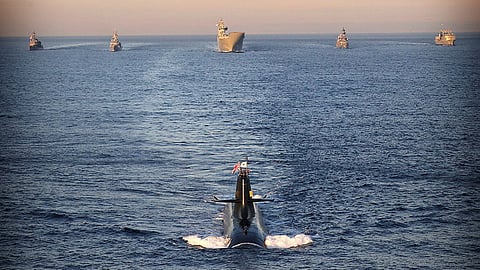

Whoever wins this weekend’s contest to lead Japan’s ruling party could throw Australia the lifeline it desperately needs to secure the future of AUKUS Pillar One amid doubts about the program’s viability.
A submarine program co-developed with Japan could ensure Australia has the naval capabilities, in a timely manner, to respond to threats in our near region, thereby complementing and strengthening AUKUS while reinforcing the pact’s aim of deterrence.
The Indo-Pacific is a primary flashpoint in international security. In recent years, the region has seen an increase in Chinese assertiveness and aggression. For example, the China Coast Guard poses a significant threat to Indonesia’s territorial integrity and maritime economy, forcing Jakarta to harden its security posture in the North Natuna Sea and bolster its own naval capabilities.
The Philippines similarly encounters frequent Chinese aggression. Footage published on August 11 showed an extraordinary collision between a Chinese warship and China Coast Guard vessel, both attempting to intercept a Philippine Coast Guard vessel that was distributing aid to fishermen in the disputed Scarborough Shoal.
Consistent Chinese incursions in the South China Sea have disrupted the rules-based maritime order, which is designed to guarantee that these vital sea routes remain free and open.
Of course, Australia has not been immune to China’s grey-zone tactics. In a heavily publicised incident in late February, three Chinese warships were spotted sailing around 250 kilometres off the coast of Sydney, breaching Australia’s exclusive economic zone. They later conducted live-fire drills in the Tasman Sea, before continuing their circumnavigation.
All this paints a grim picture of the worsening strategic environment Australia faces. Herein lies the importance of addressing the fragility of Australia’s submarine strategy and evaluating credible alternatives to complement AUKUS.
This is why we recently argued the need for not just a formal Australia–Japan defence pact, but the joint development of a new, long-range, conventionally-powered submarine designed specifically for Indo-Pacific patrols while also being interoperable with US systems.
Canberra’s August decision to purchase Japanese frigates from Mitsubishi Heavy Industries underlined the depth of trust and technical compatibility between the two countries, easing concerns over capability mismatches.
In Japan, the political conditions for such an initiative are more favourable than ever, especially if Sanae Takaichi is elected leader of Japan’s ruling Liberal Democratic Party, becoming the country’s Prime Minister. Takaichi believes in strengthening Japan’s security posture and has committed to revising its pacifist constitution in response to the country’s primary strategic challenge: China.
Japan has a century-long blue-water capability and is adept at anti-submarine warfare. Tokyo has already moved to double its defence spending over the next five years and acquire counterstrike capabilities, signalling a willingness to take on greater regional security responsibilities.
With Chinese shipbuilding outpacing that of the United States, submarine production schedules are bound to be heavily delayed. Not only that, concerns exist around poor British productivity in executing large-scale projects.
In a submission to the Australian parliamentary committee examining the submarine partnership with Britain, retired Rear Admiral Peter Briggs cautioned, among other things, Australia’s dependence on British manufacturing of SSN-AUKUS submarines, with supply lines stretching more than 19,000 kilometres in the event of conflict.
Elbridge Colby, the senior US official tasked with reviewing AUKUS, has rightly been strident in his belief that deterrence in the Indo-Pacific must be strengthened through partners willing to share more of the burden. In this context, a co-developed submarine program with Japan would demonstrate the kind of strategic imagination Washington wants.
Defence partnerships are not mutually exclusive—the US participates in many arrangements that coexist and reinforce each other, such as NATO and the Quad. As such, an Australian submarine project with Japan would still achieve AUKUS’s aims, including complementing its non-submarine pillars.
It would also firmly plant Australia into a fast and proven production line, exposing it to cutting-edge Japanese naval technology. And if Takaichi becomes Japan’s first female Prime Minister this weekend, it could be our chance to extend AUKUS and improve our regional security.
Article reprinted with permission from the Australian Strategic Policy Institute's analysis and commentary site The Strategist.
